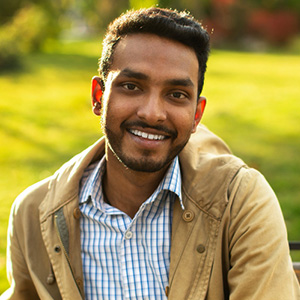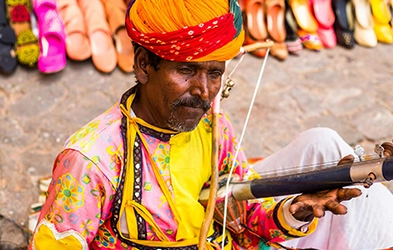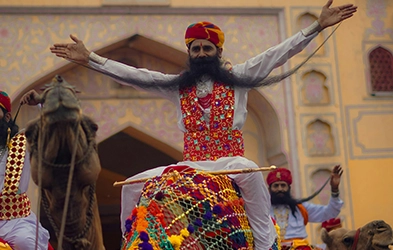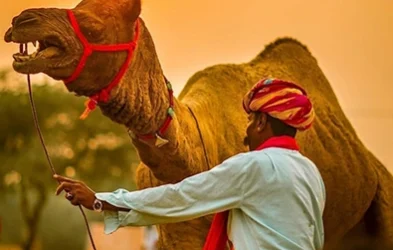Inside the Pushkar Camel Fair What to Expect & Travel Tips
Inside the Pushkar Camel Fair What to Expect & Travel Tips Every year, when the golden sands of Rajasthan shimmer under the November sun, the sleepy desert town of Pushkar…
 By Mohan Das on 30 September 2025
By Mohan Das on 30 September 2025When Mr. Johns and his family from London, UK decided to explore India, they were told about the famous Golden Triangle route — Delhi, Agra, and Jaipur. What they didn’t know was that this journey would become one of the most eye-opening, heartwarming, and unforgettable experiences of their lives.
Instead of flying between cities or rushing on trains, they chose to travel by car, guided by Rajesh from Rajasthan Tour India. What followed was a week-long adventure across royal forts, colorful bazaars, the Pushkar desert, and even a thrilling Ranthambore wildlife safari — all while discovering why road travel is the real way to see India.
The Golden Triangle connects Delhi, Agra, and Jaipur, forming a perfect cultural circuit of India’s heritage. Traveling by car gave Mr. Johns and his family the freedom to stop, explore, and experience the places most tourists miss when they fly.
“The journey between destinations became part of the holiday itself,” Mr. Johns later said, smiling as he recalled the roadside dhabas, chai stops, and local stories.
Landing in Delhi, the family was welcomed by Rajesh and his friendly driver, Sanjeev. Their first impression of India was a mix of chaos and charm — honking cars, colorful saris, street food aromas, and a thousand smiles.
They explored:
Old Delhi: A rickshaw ride through Chandni Chowk, savoring jalebis and parathas.
Red Fort & Jama Masjid: Glimpses of Mughal grandeur.
India Gate & President’s House: Perfect sunset photo spots.
At night, they stayed in Haveli Dharampura, a restored Mughal-era mansion with royal interiors. Neha, the youngest, exclaimed, “It feels like we’re staying in a palace!”
Early the next morning, their SUV headed toward Agra, a smooth 3.5-hour drive along the Yamuna Expressway. On the way, Sanjeev shared tales of India’s emperors and dynasties, keeping everyone fascinated.
By noon, they stood before the Taj Mahal, its white marble gleaming in the sun. Mr. Johns was speechless. “It’s more magical than in pictures,” he whispered.
Later, they visited Agra Fort and the lesser-known Mehtab Bagh, where they watched the Taj Mahal glow orange during sunset.
Dinner was at Pinch of Spice, a local favorite, where they tried butter chicken and naan for the first time.
Instead of a direct drive, Rajesh suggested a detour through Fatehpur Sikri, the abandoned Mughal city. The red sandstone palaces and intricate carvings amazed them. Their guide explained how Emperor Akbar once ruled from here — a glimpse into India’s royal past.
Continuing toward Jaipur, they stopped for chai and pakoras at a roadside café, chatting with locals about Rajasthan’s culture and festivals. “You don’t get this connection if you’re flying,” Mrs. Johns said.
Upon arrival in Jaipur, they checked into Alsisar Haveli, where traditional Rajasthani décor and warm hospitality made them feel at home.
That evening, they explored Chokhi Dhani, a cultural village filled with folk music, puppet shows, camel rides, and a feast of dal baati churma.
Jaipur, the “Pink City,” was a highlight for the Johns family. Their day began with a drive to Amber Fort, where they rode elephants up the ramparts like the old kings once did. From the top, the views of Maota Lake and the city below were breathtaking.
They also visited:
City Palace: A blend of Mughal and Rajput architecture.
Hawa Mahal: The famous Palace of Winds.
Jantar Mantar: The 18th-century astronomical observatory.
Lunch at LMB (Laxmi Misthan Bhandar) introduced them to Rajasthani flavors — gatte ki sabzi, ker sangri, and ghewar. In the evening, they shopped for gemstones and block-printed textiles in Johari Bazaar.
Rajesh recommended adding two days to experience Rajasthan beyond the Golden Triangle, and the Johns family couldn’t resist.
First stop: Pushkar, the desert town famous for its Camel Fair and holy lake. They enjoyed a camel safari at sunset, with golden dunes glowing under the fading light. “This feels like a movie,” Mrs. Johns said as local musicians played folk tunes nearby.
The next day took them to Ranthambore National Park for a wildlife safari. The family spotted deer, langurs, and even a tiger! Aarav, the young explorer, declared it “the best day ever.”
They spent the night at Tigress Resort Ranthambore, where bonfires and local cuisine made the evening memorable.
Unlike flights or trains, traveling by car allows spontaneous stops — whether for roadside chai, a hidden fort, or a stunning photo opportunity.
The Johns family met locals, tried street food, and learned about traditions directly from people — experiences impossible to get on a flight.
The highways between Delhi, Agra, and Jaipur are modern and well-marked. The changing landscapes — from urban bustle to rural peace — add charm to the journey.
With private vehicles, there’s no luggage hassle, no fixed schedule, and it’s surprisingly affordable when traveling as a family.
Rajesh ensured clean, air-conditioned cars, bottled water, and reliable drivers — offering both comfort and flexibility.
Delhi: Paranthe Wali Gali for authentic Indian breakfast.
Agra: Petha sweets and Mughlai dishes.
Jaipur: Dal Baati Churma, Ghewar, and Lassi at Lassiwala.
Pushkar: Falafel wraps and local chai at lake-view cafés.
Ranthambore: Rajasthani thali under the stars.
Delhi: Haveli Dharampura or The Claridges
Agra: Trident Agra or ITC Mughal
Jaipur: Alsisar Haveli or Samode Haveli
Pushkar: Ananta Resort or Dera Masuda
Ranthambore: The Tigress Resort or Oberoi Vanyavilas
Each stay offered traditional hospitality, safety, and comfort — especially important for families traveling from abroad.
Best Time to Visit: October to March – pleasant weather and vibrant festivals.
Dress Modestly: Lightweight cotton clothes, scarves, and hats for sunny days.
Carry Cash: Some rural areas don’t accept cards.
Respect Customs: Remove shoes before entering temples.
Learn a Few Words: “Namaste” and “Dhanyavaad” go a long way!
Q1. Is it safe to travel the Golden Triangle by car?
Yes, it’s very safe. Highways are modern, and professional drivers like those arranged by Rajesh ensure comfort and security throughout.
Q2. How many days are ideal for this trip?
6–8 days is perfect for Delhi, Agra, and Jaipur, but adding Pushkar or Ranthambore makes it even richer.
Q3. What kind of car should foreign tourists choose?
SUVs or sedans with AC are ideal. Rajasthan Tour India provides reliable, sanitized vehicles with English-speaking drivers.
Q4. Are the roads comfortable for long drives?
Absolutely. The expressways are smooth, with plenty of clean rest stops and cafes along the route.
Q5. Can this tour be customized for families?
Yes. Rajesh specializes in tailor-made itineraries — from family-friendly resorts to private guides.
Q6. What documents do UK tourists need for road travel?
A valid passport, Indian visa, and travel insurance. The rest (permits, bookings, local arrangements) are handled by the tour company.
For Mr. Johns and his family, the Golden Triangle by car wasn’t just a sightseeing trip — it was a journey into India’s living history. From Mughal architecture in Delhi and Agra to Rajput royalty in Jaipur and desert charm in Pushkar, every mile offered a new story.
Flying might have been faster, and trains might have been cheaper, but driving through Rajasthan gave them what no other mode of travel could — freedom, connection, and discovery.
“India is not just a destination; it’s a feeling you must drive through,” Mr. Johns said as he bid farewell to Rajesh in Jaipur.
If you’re planning a Golden Triangle trip from the UK or anywhere abroad, Rajasthan Tour India can craft the same road adventure — comfortable, cultural, and unforgettable.

Inside the Pushkar Camel Fair What to Expect & Travel Tips Every year, when the golden sands of Rajasthan shimmer under the November sun, the sleepy desert town of Pushkar…

7 Day Rajasthan Road Trip The open road, desert hues, royal palaces, and family laughter echoing across Rajasthan — that’s how the Mehra family from Delhi will forever remember their…

Why the Golden Triangle by Car Is Better Than Flights or Trains When Mr. Johns and his family from London, UK decided to explore India, they were told about the…